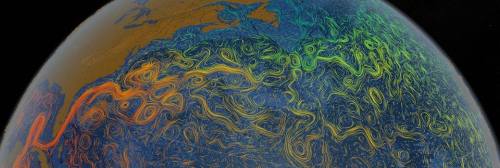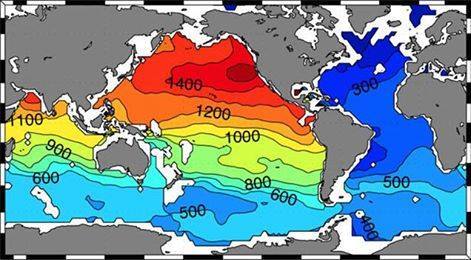Swim with a VikingThe ocean is in constant motion. Forget about waves and tides here - in the grand
Swim with a VikingThe ocean is in constant motion. Forget about waves and tides here - in the grand scheme of things, they don’t move that much water. We’re talking about the ‘global ocean conveyor belt’. A vast, global circulation system driven by the Sun and the spin of the Earth, which moves water from surface to the deep and back, and between every ocean basin on the planet.This cycle is big and slow. Water that sinks into the depths in the North Atlantic won’t come back to the surface for 1300-1500 years. This means that if you were to go swimming in the North-East Pacific, there’s a fairly good chance that the last person in that water was a Viking. The image above shows us how old the deep water (2500 m) is in different parts of the world.This system is more correctly called 'thermohaline circulation’. It is mainly driven by changes in temperature ('thermo’ = heat) and salinity ('haline’ = salt), which determine where water sinks, and where it rises to the surface. Once water sinks or rises, the path of the currents is determined by the rotation of the earth, and the shape of the continents. This global cycling of the oceans determines long-term climate, fuels the productivity of the ocean, and maintains global chemical cycles that keep the planet in balance.This circulation process is… complex, but here are the basics: the density of seawater is determined by its salinity and temperature. Hot, fresh water is less dense, and cold, salty water is more dense. Imagine a bucket of seawater at the equator - the hot sun will heat it up, and cause a lot of evaporation, which will make the water more salty, and more dense. However, if you poured your bucket into the ocean in the Carribean, it wouldn’t sink because it’s warmer, and therefore less dense, than the water underneath. Now take that bucket on a long journey North, let’s say Iceland. It’s much cooler up there, and your warm, salty bucket of water gets cold. If you poured this cold, salty water into the sea off Iceland, it would sink. This cold, salty liquid is about as dense as seawater can get.Once it gets moving, the water has momentum. Dense, sinking water pushes the water underneath out of the way, and shunts it along the ocean floor, directed by the shape of the ocean floor, and the spin of the Earth. As the Earth spins, there’s a tendency for water to be 'left behind’ - think about what happens if you suddenly move a glass of water (don’t try this near your computer!) - the water wants to stay still, and sloshes up the side of the glass. This is basically what happens to an ocean current: as a current moves South in the Northern Hemisphere, it will gradually bend to the right, as the movement of the Earth 'leaves it behind’. This is known as the Coriolis Effect, [and is the reason that water going down a plug-hole spins clockwise in the Northern Hemisphere, and anti-clockwise in the Southern Hemisphere - we originally put this in here, but it’s NOT TRUE! The Coriolis effect is far too weak at this small sale to have an effect - the design of the basin is more important in which way your pughole-water spins. Thanks to our readers for correcting this. An ocean current will flow along, affected by Coriolis, until it hits a barrier (i.e. a continent) and is deflected. This sets the path of global thermohaline circulation.Our bucket analogy, while ridiculous, is pretty much what happens. Ocean circulation is mainly driven by warm salty water zooming North up the Gulf Stream, cooling and eventually sinking in the North Atlantic. There is a constant 'underwater waterfall’, as this dense water sinks and begins to flow South. This deep current hugs the East coast of America (Coriolis, remember?), and eventually joins the Antarctic Circumpolar Current, which flows round and round the South Pole. Tongues of this circular current lick up into the Indian ocean, and into the South Pacific. The South Pacific current heads North East until it hits North America, where the water has nowhere else to go, and is forced to the surface. This is why the Pacific Coast of the USA has such delightfully cold water, and it’s somewhere around here that you might be able to swim with the Vikings. Once on the surface, The water starts its slow journey back to the North Atlantic, via the Indian Ocean, round the Horn of Africa, in the ferocious Agulhas current, and back up the Western Atlantic to form the Gulf Stream, which keeps Western Europe warm. These currents are unimaginably vast. The largest one, the Antarctic Circumpolar Current, flows at 125 Sverdrups. That’s 125,000,000 cubic meters per second. Or 50,000 Olympic swimming pools per second. Or 600 times the flow of the Amazon (largest river on Earth, by discharge). And yet, despite the size of these currents, one complete circulation can take up to 3000 years.The picture above is complex, but doesn’t begin to scratch the surface of these global ocean processes. Oceanographers spend their entire lives trying to work out the peculiarities of ocean currents, and how they tie in to climate and our daily lives. A pressing question at the moment concerns the flow of the Gulf Stream: melting of ice sheets have the potential to disrupt a lot more than Polar Bears. The worry is that as the Greenland Ice Sheet melts, it will dump a huge amount of fresh water into the North Atlantic. As we know, fresh water is less dense, and could mix with North Atlantic water and stop it sinking, and take away the main driving force behind the 'conveyor belt’ circulation. It’s almost impossible to work out what this would do to ocean circulation. The world is as we know it because the ocean currents move the way they do.OBImage Credit: http://goo.gl/FBMrdr, via http://goo.gl/TRNhcNASAFurther Information:- The ocean currents in action (video): http://goo.gl/UHsJ6mWatch the Gulf Stream flowing and cooling (video): http://goo.gl/xvIXXHMore detail on thermohaline circulation (NOAA): http://goo.gl/m2HMZmAnd a lot of detail (Scientific paper): http://goo.gl/FBMrdr -- source link
Tumblr Blog : the-earth-story.com
#science#ocean#water#current#saline#thermohaline#circulation#salt water#fresh water#conveyor belt

